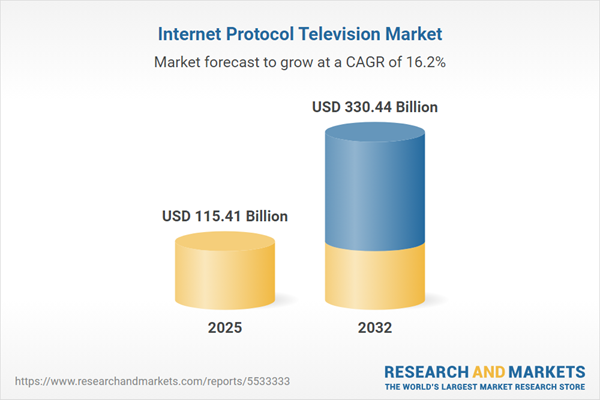Speak directly to the analyst to clarify any post sales queries you may have.
The IPTV market stands at a pivotal stage as digital transformation accelerates and enterprises seek advanced strategies for scalable video delivery and user engagement. Success hinges on adaptive leadership and actionable insights that address both evolving technologies and shifts in audience behavior.
Market Snapshot: IPTV Market Size and Growth Trajectory
In 2024, the global IPTV market generated USD 99.57 billion in revenue and is forecasted to reach USD 115.41 billion by 2025 at a compound annual growth rate of 16.17%. This growth is attributed to strengthened broadband infrastructure, rapid advancements in broadcasting technology, and consistent investment from both enterprise and residential sectors. The expansion of IPTV providers into emerging markets stimulates competition and drives innovation. Market participants—including technology vendors, content aggregators, and platform operators—are introducing adaptive video delivery solutions that reinforce IPTV’s key position in the global digital media ecosystem.
Scope & Segmentation: IPTV Market Insights
This comprehensive IPTV market report delivers targeted segmentation and analysis supporting leadership, strategic planning, and product development for senior decision-makers. The report facilitates identification of high-potential investment regions and operational priorities relevant to a rapidly expanding industry.
- Service Types: Encompasses live television, near video-on-demand, time-shifted viewing, advertising-supported video on demand, subscription-based models, and transactional formats. These segmentations enable organizations to diversify revenue streams and align services with consumer viewing preferences.
- End Users: Includes healthcare, hospitality, and residential markets, each requiring tailored solutions. Such segmentation drives innovation through customizable platforms and specialized content geared to sector-specific needs.
- Deployment Models: Covers hybrid IPTV solutions, fully managed deployments, and IPTV-OTT integrations. These deployment structures give providers the flexibility to meet performance, scalability, and network configuration goals.
- Device Platforms: Supports a multi-device experience spanning smartphones, computers, set-top boxes, and Smart TVs operating on systems like Android TV, Tizen, or WebOS, thereby extending reach to diverse audiences.
- Components: Comprises customer premises equipment, headend devices, middleware, electronic program guides, and associated support services, ensuring operational reliability and seamless viewer experience.
- Geographic Coverage: Addresses unique regional dynamics across the Americas, Europe, Middle East & Africa, and Asia-Pacific. Analysis factors in regulatory changes, adoption rates, and market maturity for a nuanced understanding of growth opportunities.
- Top Industry Players: Profiles influential companies such as AT&T Inc., Verizon Communications Inc., Vodafone Group Plc, BT Group plc, KT Corporation, Charter Communications, Telefónica S.A., Liberty Global plc, Cox Communications, and Rogers Communications, highlighting their impact on standards and competitiveness.
Key Takeaways: Strategic Insights for IPTV Market Stakeholders
- Investments in broadband infrastructure and adoption of cloud-based IPTV platforms are enhancing reliable, scalable video delivery and unlocking new enterprise and consumer opportunities.
- Artificial intelligence applications are driving improved content recommendations, streamlining user discovery, and advancing viewer retention and engagement across IPTV platforms.
- Integration of edge computing minimizes latency and enables interactive functionality, empowering businesses to personalize content and elevate user experiences.
- Standards-based modular software architecture accelerates IPTV integration and allows providers to swiftly adapt to changing consumer expectations and optimize network performance.
- Advanced analytics support precise advertising and audience targeting, strengthening platform monetization strategies and offering deeper visibility into viewer trends.
- Regional factors remain important, with North America emphasizing content personalization, Europe transitioning through regulatory shifts, and Asia-Pacific experiencing rising demand for mobile-driven video services.
Tariff Impact: 2025 U.S. Tariffs and Supply Chain Strategies
With United States tariffs scheduled for 2025, IPTV providers are encouraged to reassess global supply chains, pursue supplier diversification, and deepen partnerships with local manufacturers to maintain resilience. These steps can secure operational continuity under evolving regulations and fluctuating trade environments.
Methodology & Data Sources
The IPTV market analysis leverages executive interviews, ongoing regulatory monitoring, industry whitepapers, and detailed financial reviews. This multi-pronged methodology ensures actionable intelligence and supports robust decision-making for IPTV service investments and strategic operations.
Why This IPTV Market Report Matters
- Guides technology upgrades, platform expansion initiatives, and agile partner relationships as IPTV markets continually evolve under pressure from emerging digital media trends.
- Clarifies the interplay of regulatory, competitive, and operational dynamics, enabling leaders to minimize risks and recognize global growth opportunities.
- Arms executive teams with the insight needed to maximize service potential, align infrastructure investment, and meet enterprise and consumer expectations.
Conclusion
This report equips senior executives with critical analysis to align IPTV strategies with ongoing industry transformation, driving informed decision-making for innovative engagement, sector growth, and sustained business resilience in the digital video domain.
Additional Product Information:
- Purchase of this report includes 1 year online access with quarterly updates.
- This report can be updated on request. Please contact our Customer Experience team using the Ask a Question widget on our website.
Table of Contents
3. Executive Summary
4. Market Overview
7. Cumulative Impact of Artificial Intelligence 2025
List of Figures
Companies Mentioned
The companies profiled in this Internet Protocol Television market report include:- AT&T Inc.
- Verizon Communications Inc.
- Vodafone Group PLC
- BT Group PLC
- KT Corporation
- Charter Communications, Inc.
- Telefónica, S.A.
- Liberty Global PLC
- Cox Communications, Inc.
- Rogers Communications, Inc.
Table Information
| Report Attribute | Details |
|---|---|
| No. of Pages | 183 |
| Published | November 2025 |
| Forecast Period | 2025 - 2032 |
| Estimated Market Value ( USD | $ 115.41 Billion |
| Forecasted Market Value ( USD | $ 330.44 Billion |
| Compound Annual Growth Rate | 16.1% |
| Regions Covered | Global |
| No. of Companies Mentioned | 11 |









